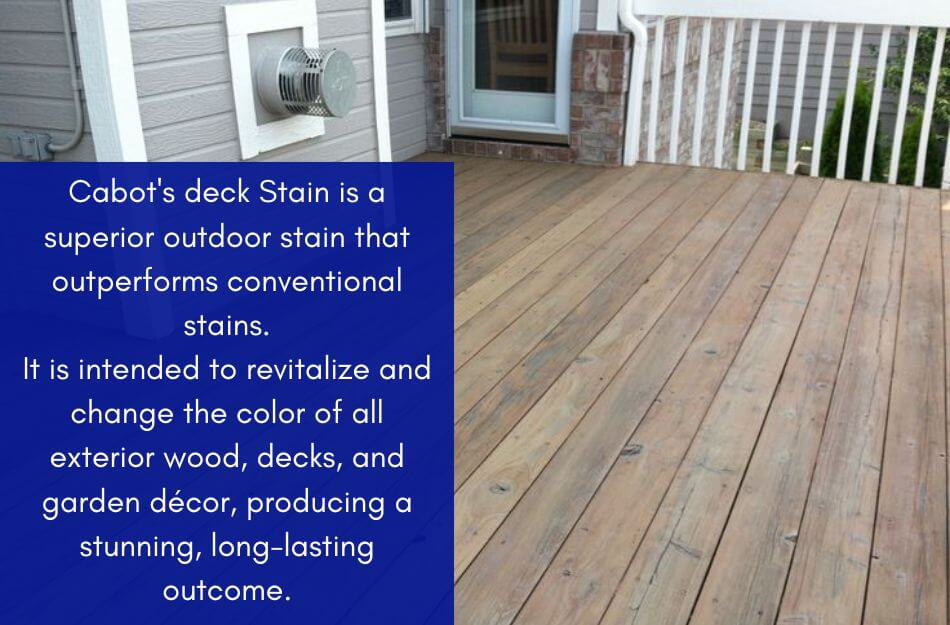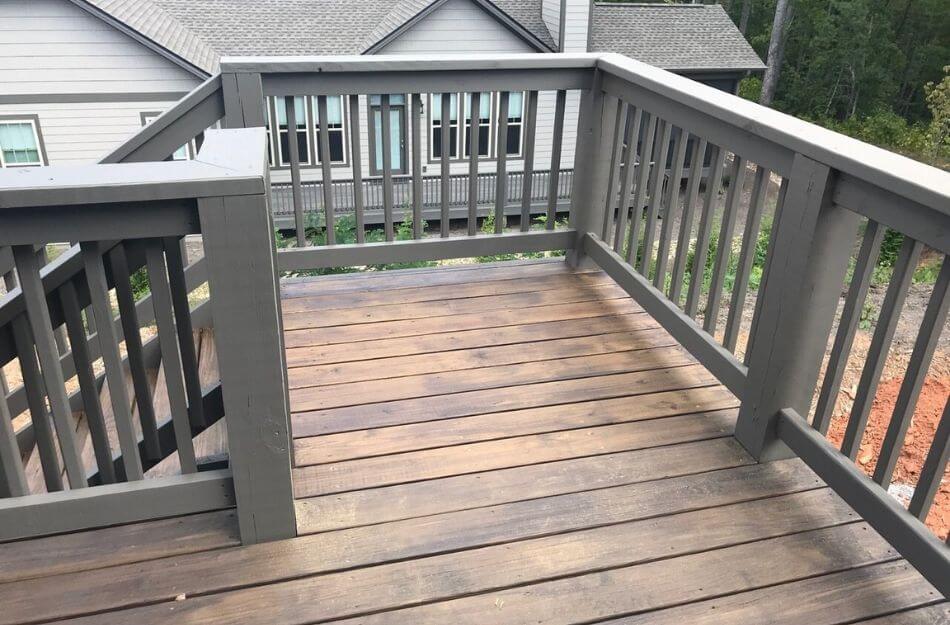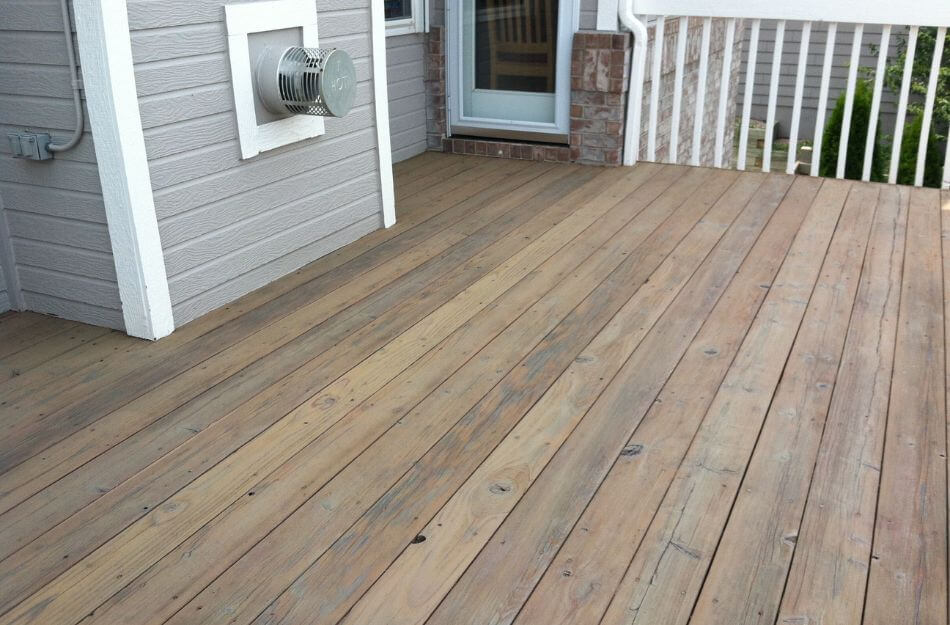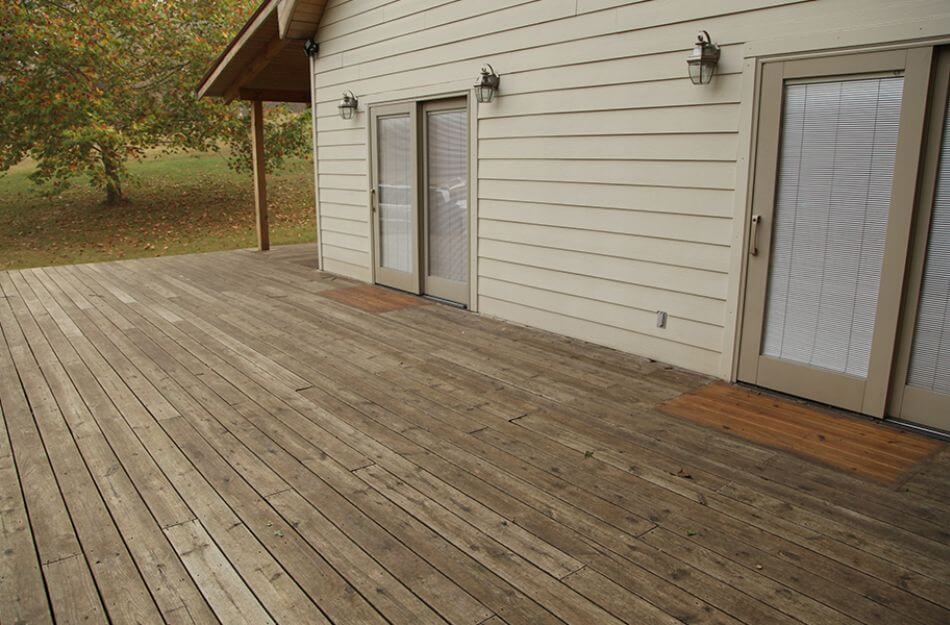A wood deck can become faded and dull due to damaging UV rays, torrential rain, and temperature extremes. A high-quality stain can provide additional weather protection and improve its look.
Consequently, Cabot Deck Stain is the finest remedy for the issue.
Cabot’s Deck Stain is a superior outdoor stain that outperforms conventional stains. It is intended to revitalize and change the color of all exterior wood, decks, and garden décor, producing a stunning, long-lasting outcome. Cabot wood stains give UV or mildew protection and a hint of color, and they are less likely to diminish over time.

Read on to discover the pros and cons of Cabot stain as well as what to consider when selecting Cabot deck stain for your outdoor wood structure.
Table of Contents
What is a Cabot Deck Stain?
Cabot deck stains are deeply penetrating stains that enhance and safeguard exterior wood.
These sparsely pigmented stains bring out the wood’s inherent beauty by letting grain, texture, and color differences shine through.
Acrylic 1300 series blends water-based finishes’ simple soap-and-water cleanup with the penetrating qualities of oil-based coatings.
It will offer vapor-permeable, long-lasting protection that enhances and beautifies exterior wood surfaces. Designed with earth-tone pigments that won’t degrade over time.
Cabot’s Stain is a good choice for a deck with mismatched boards or needing a total color change. They have a high pigment content and provide better coverage and UV protection to hide flaws.
Since Cabot deck stain products have minimal VOC content, you couldn’t smell any fumes. One layer of this stain is required to revive a deck needing a pick-me-up because the color is so deep.
The test board’s tone was just as dark and rich, and it still effectively resisted water after spending three weeks outside.
Since it can hide most of the wood grain and give a consistent color, this stain is ideal for updating a deck with mismatched boards.
Features
The following features of Cabot deck stains are:
- Water-repellent, deep penetrating formula
- Outstanding UV resistance
- Enhances wood with a special resin and oil blend for a premium translucent finish
- Flawless results on pressure-treated wood, plywood, redwood, cedar, and pine
- Specially formulated to give bare wood a better natural finish.
Pros
- Heavy-duty restaining-appropriate
- Corrosion- and fade-resistant formula
- Numerous finishes
- Single-coat application
Cons
- Covers up a lot of the wood grain
How to Use Cabot Deck Stain?
Decking materials are very sensitive, any mistake can damage the wood or make it appear bad, that’s why it is important to know the correct way of using Cabot stain in order to prevent any damage to the wood and also you can save yourself and your family as it contains toxic chemicals.

Below is the proper guide for how to use the Cabot deck stain properly:
Application Directions
Before You Start guidelines there are a few things to consider:
- Cover nearby bushes and flowers.
- Always apply it to a tiny test area and allow it to dry.
- The surface should be clean, porous, and free of any previous finishes.
- For concrete, sprinkle a couple of drops of water on the surface
- if they are rapidly absorbed, the surface is ready to prep.
- Let the wood dry in the open air for three to five days.
Preparation Warning
Before preparing the area it is important for you to follow these precautions to protect yourself:
- Lead dust or vapors may be produced during the sanding, scraping, or other methods to remove old paint.
- Exposure to lead fumes or dust may damage the brain or cause other adverse health impacts, particularly in toddlers or pregnant women.
- A correctly fitted respirator (NIOSH certified) and appropriate containment and cleanup are required to mitigate exposure to lead or other potentially dangerous chemicals.
Surface Preparation
Below are the points to prepare your surface properly:
- If necessary, sand the surface with 80-100-grit sandpaper (120-180 grit for rougher areas).
- Replace severely deteriorated or rotted boards.
- To get rid of grime, mildew, and other pollutants, use a wood cleaner.
- To get rid of rust spots, tannin bleed, or discoloration, use a wood brightener.
- Remove old water- or oil-based coatings as needed.
- Check the label for more specific instructions.
Application Steps
Here are the steps for applying the Cabot deck stain on your deck below:
- Two coats of coating are advised. Before using, fully stir.
- Use a premium pigment brush to apply. Work in 2-3 sections with a complete board.
- Apply a uniform coat of Cabot deck stain to entire boards from end to end, keeping a wet edge to prevent lap marks. Spot-treat any dry areas around knots. Applying less finish is not recommended, especially where there are fissures.
- Before putting a second layer, the first coat should have at least one night to dry completely. After the first coat, the finish may look uneven; another coat adds safety and gets a consistent hue and depth.
- Before applying the second layer, gently sand any rough areas with 220-grit sandpaper and brush off any dust for the best appearance. You can delicately clean up any bleed-back from fissures.
- If the project calls for more than one container, combine them all to guarantee uniformity.
Precautions of Cabot Deck Stain
Cabot deck stain contains aliphatic hydrocarbons that’s why it is considered as a toxic stain sometimes. Before using cabot deck stain there are some considerations to keep in mind in order to protect you and your family.
- Avoid exposure to fire and open flame.
- It is a harmful vapor that is used only where there is enough air.
- Open windows and doors or use other techniques to allow fresh air entry during application and drying to prevent overexposure.
- Increase the amount of fresh air in the area, wear respiratory protection that NIOSH has authorized, or leave if you feel headaches, dizzy, or watery eyes.
- Limit contact with the epidermis and eyes. Afterward, wash your hands.
- When not in use, keep the container covered.
- Do not move items to different storage containers.
- FIRST AID: If eye contact occurs, immediately seek medical care and flush the eyes vigorously with lots of water for 15 minutes. Wash completely with soap and water if skin contact occurs.
Different Types of Stains React Differently to Wood
Consider how the stain will respond to your wood before choosing a color and type. While some stains draw attention to the wood’s inherent features, others give the surface a more uniform tone.

For instance, oil-based stains infiltrate the wood more deeply and give it a deeper color, whereas water-based stains highlight the color of the wood grain.
Gel stains work better on woods like pine because they help to provide more even coverage and are less prone to blotching.
Additionally, the environment can affect the best stain; for instance, an outdoor wood stain must be water-resistant to avoid warping, cracking, or splintering.
Outdoor stains are typically acrylic- or oil-based, available in various colors, and adhere to wood in various ways.
Before making a choice, consider the type of wood you have and your choices for different stains.
Choose Cabot Deck Stain Color
One stain application is clearer than two or three, so the amount of stain you apply will also affect the final hue. Lighter materials work best if you want a more contemporary look.
Pinewood stained with a translucent stain or using just one layer of your preferred stain are good examples.
Try a “pickled oak” stain for a moderate tone, or go with a darker, more penetrating stain like “jacobean” if you want the difference in a light area.
Golden oak and golden pecan are suitable options for more reddish tones and affordable hues. You’ll be fine if you consider your decor and how the stain color fits it; try them to help you determine which works best.
How Long Will The Can of Cabot Deck Stain Last?
You might discover that after completing that significant staining job, you still have many deck stains on hand. Well, tossing it out would be a waste.

However, there are several things you should be aware of first if you plan to keep it. If you stick to these easy instructions, your stains will remain useful.
Unopened Deck Stains Cans
Like normal paint, deck stain cans have a shelf life of up to 5 or 6 years before they deteriorate. There is, therefore, no need to worry if you need more time to begin your endeavor this year.
Within this period, you are free to use the paint whenever it is convenient.
Within this period, you are free to use the paint whenever it is convenient. Make sure to keep the Cabot deck stain in a space with a regulated temperature.
Keep the discoloration from freezing. If your stain has been sitting for a while, it is advised to bring the can to a hardware or home improvement store so they can shake it up and make sure it is available for use.
Used Deck Stain Cans
A more frequent issue is that the pigment can is only halfway used after you’ve finished your deck and opened it. What are your options here? Most opened stains can last more than a year if properly kept and the lid is securely closed.
Ensuring the container is properly sealed is crucial because if the substance touches the air, the solvents evaporate. You won’t be able to use your stain again.
What to Consider About Deck Stains Before Choosing?
When choosing the deck stain from the shop you might wonder which is the best stain for your deck, don’t worry here are some factors you need to consider in order to choose the right stain for you.
Opacity
The stain makes the wood’s original grain and texture visible. Its opacity describes the amount of or little covering the stain offers.
Since clear stain has no color, protecting the wood while revealing its full, natural beauty is a good option.
For more expensive hardwoods like IPE and oak, which have a rich pattern and structure that you would want to avoid being covered up with a more opaque stain, Clarke claims that translucent stains work well.
If you want to give your deck a tint, you can choose a semi-transparent stain that gives some color but still allows much of the grain to be seen.
Type
Before buying exterior stains, you should be aware of the previous stain type used, the age, and the present state of your deck.
Choosing a more costly stain if your deck is old and you need more time to apply fresh stain frequently.
The opacity and color of your wood deck will depend on personal preference, but the kind of deck stain you need will depend on the wood used to build it.
Solid and semi-solid stains work best for wood pine and other less expensive, softer woods.
Semi-solid stains provide more color with less visible wood texture. It is a good choice if your deck is older or if there are wood flaws that you’d like to hide.
The dense stain is the solid stain. You’ll get a rich, deep hue, but the natural grain won’t appear.
Color
Stains are available in various hues besides clear, depending on the brand. The ideal option is to paint your deck the same color as the trim on your house.
As a result, your deck will stand out toward the color of your house for an integrated appearance while highlighting its structure and character.
Limitations on Temperature
Deck stains can take longer to cure if they are too hot (over 90°F) or cold (below 40°F) outside. Although there is a large spread between 40 and 90 degrees Fahrenheit, humidity is more crucial than temperature.
The drier and more cured your stain layer, the lower the humidity.
Dry vs Cure Time
Whichever deck stain you choose, read the label to find out how long the maker recommends it should dry. Remember that a deck that feels dry to the skin probably needs to prepare for walking.
A deck may not have fully dried out, so the stain has soaked into the wood fibers to reveal its true color, even though it is completely dry and suitable for foot traffic.
Last Thoughts
Cabot provides the finest wood stains and finishes for your decks, fences, siding, and outdoor furnishings. Accentuate the attractiveness of wood while offering weatherproofing.

Cabot guarantees outstanding durability and more than a century of innovation in every can.
The only decision left to make when selecting the best treatment for your wood surfaces is color. Consider using a strong exterior stain to conceal issue areas or mismatched boards if you’re dealing with old, worn-out wood with imperfections.
Stains can be applied just like paint. Protecting exterior surfaces is a skill that even DIY novices can pick up quickly.
Cabot is equipped for each stage of the procedure, including assessing the condition of the wood, preparing a surface for stain application, using stain, caring for a stain over time, and more.
Recent Posts
Although deck sealing may not be at the top of your summer to-do list, you shouldn’t put off a task.One such deck that channels the opposite of the lively and enjoyable vibe you want from an...
Any home would benefit from having a deck because it adds more area for socializing, relaxing, and outside activities.Garden decking that has been properly polished can be elegant and lovely. It...
